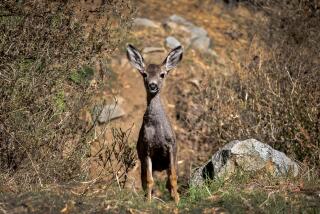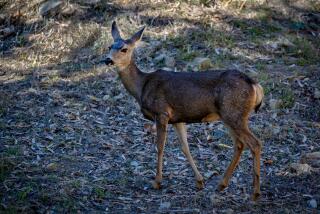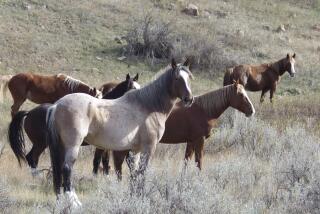Residents of a seaside community are split over efforts to rein in a herd of wild horses.
BEAUFORT, N.C. â Like the sea that surrounds it, this delightful little fishing village usually seems placid enough on the surface--sun-bleached, with stately old white houses and crepe myrtles that line the streets.
But as sure as the sea is bound to rage from time to time, strong currents of discord run deep here.
What, one wonders, could disrupt the unpretentious, laid-back splendor of this town of 5,000, whose quaint shops and restaurants make it feel like an uncute-ified Carmel?
Wild horses. They have inspired impassioned newspaper editorials, pitted neighbor against neighbor and focused new attention on the areaâs balance of people, animals and their environment.
The horses graze on wind-swept Carrot Island, 2,300 acres of serene marshland, a short boat ride across Taylorâs Creek. The island is part of the Rachel Carson National Estularine Research Reserve, a complex of marshes, tidal flats and grass beds where the famed environmentalist did research in the 1940s.
For many here, the animals are a joy to see, a part of the wild and free landscape, not to mention a tourist draw. But for others, they are destructive beasts whose incessant eating destroys the marsh grasses that trap sand and help prevent erosion of the barrier island. âIâd rather see them off the island,â said Ann Carter, a town commissioner. âIt is not their natural habitat. But Iâm careful where I say that around here. I donât want to be lynched.â
Mamre Wilson, who owns an art studio, said: âIâd hate to see them go. They make such a nice picture, and theyâve been here for generations.â
Even where the horses came from--and when they came--is debated. Some say they descended from horses that swam ashore from Spanish shipwrecks in the 16th Century, but ânobody knows for sure,â said John Kinde, a park ranger with the U.S. Interior Department.
What is known is that they numbered 67 in 1986, and that a third of them died, apparently starving to death because the marsh grasses had been so depleted. Some local residents organized âhayliftsâ to feed the animals, while others called for their removal, arguing that they were destroying the island and running out of food.
Last year, state officials stepped in, rounding up some of the horses and putting them up for adoption and setting up a system to manage the smaller herd.
âIt seems to be going fine,â said Ernest Carl, deputy secretary of the state Department of Environment, Health and Natural Resources. âThe herd is low now.â
Currently, 19 horses are left, but thatâs 19 too many, as far as Mark Hay is concerned.
Speeding across Taylorâs Creek in a motorboat, Hay, a marine sciences researcher at the University of North Carolina, pointed to an area where the horses have not grazed. âYou notice over here you get tall grasses!â he shouted over the motorâs roar. Then, gesturing in another direction: âBut over on the island, you donât!â
Indeed, on the awesomely quiet island, the evidence is graphic. Amid the egrets, fiddler crabs, pelicans and sea gulls, horses can be seen grazing constantly, and where they have been, grasses are gone. Hay said that without grasses, not only could the island erode, removing an important buffer for the mainland, but wildlife that depends on the grasses for food and nesting might be harmed as well.
Hay and colleagues have set up fenced spaces he calls âexclosuresâ that demonstrate how much taller the grasses grow when the animals are not allowed to graze. Hay called horses and the island âincompatible,â likening the current situation to âhaving a large sandbox that you take hay to.â
Back in town, Hay has his detractors. Ed Book, editor and publisher of the Eastern Weekly newspaper, said: âHeâs a marine biologist. What does he know about horses? Horses do for themselves. They manage to keep themselves relatively stable.â
On one level, the debate centers on which should survive, the island or the horses. On another level, the debate is simpler, focusing on the struggle between the joy of life and the grief of death.
Book, who also owns the Royal James Cafe, bar and pool hall, which sports a sign reading, âEnjoy every minute (thereâs plenty of time to be dead),â said removing the horses from the island âwould disturb a whole lot of peopleâ because they âgive people the sense that life is still free.â
At the Inlet Inn, night clerk Jay Anders also loves the horses, which at times can be seen from the inn, because they provide âa sense of beauty.â
Ann Carter, however, shudders when she recalls the starvation three years ago. She fears a recurrence. As she and others were helping feed the animals, she said, one horse died with its head on a womanâs lap.
âYou canât see the bones from over here,â Carter said.
More to Read
Sign up for Essential California
The most important California stories and recommendations in your inbox every morning.
You may occasionally receive promotional content from the Los Angeles Times.










